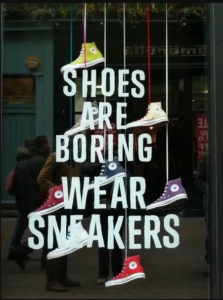Take This Marketing Challenge!
You run a business, and you know you need to do your marketing.
Yeah, yeah, you’ve heard it before – if you don’t market, you don’t sell.
But come on, everyone knows small business owners are busy.
We haven’t got time to do all this Business School stuff! We market by treating our customers right, by giving them what they want, and we market by painting a big sign outside and paying for an ad in the corner of the newspaper.
Right?
Well, I’m saying to you – not only is that not true, but that’s also not the kind of marketing that will bring people to your doors.
That is not the kind of marketing that will grow your business.
In fact, that’s the type of “marketing” that keeps you in your rut and keeps you too busy to do anything to grow your business, because that’s struggle-street marketing.
That’s the kind of marketing you do when you don’t know how to market and you go back to rely on what you know best – just doing what you’re doing!
You can market more effectively.
You can find the time if you do it scientifically and here’s how.
Here’s my challenge to you.
You can do this – you just need the decision that this time, you will do it more effectively to gain the benefit of making more sales, and then you need the science.
I know you worry about wasting time but let’s just spend only a couple of hours working this out, and then some time here and there practising this stuff for the next week.
What have you got to lose? Let’s do this!
For this challenge, let’s pick a service or product that you really want to push – something you believe in and feel that your customers haven’t really appreciated what a great product it is (even if it’s a service, I’m going to call it a product from here on).
Put aside an hour or so, and with this product in mind, start by listing all the features of your product – what makes it great?
If the product you sold is a power drill, list all the features of the product you think are great.
Perhaps it’s the price – great value for money.
You might include the light-weight plastic it’s made of, the inter-changeable battery, the ability to flick a switch between hammer drill and screwdriver.
If you’re a garage mechanic and you chose your half-yearly car service package you may think that its great features are your experienced mechanics, your use of quality spare parts, and tooled up garage that can tackle any vehicle.
You get the idea – what are the great physical features that make up your product or that are part of the way your product is put together.
You should find this quite easy to do because this is the stuff you are familiar with.
If you advertise, I’d almost bet that these features are what you include in your ad.
Now comes the challenging part.
Looking at your list of features for this product, ask yourself how your customer will benefit from this feature?
Remember this – people don’t buy with their brains, they buy with their hearts.
They may recognise the quality of the light-weight plastic, but that’s not why they buy.
They buy because they like it or something about it appeals to them, and then their minds justify it by referring to the quality materials.
So to work your way to their hearts, identify why they benefit from buying your product.
Here are some examples of how features could represent benefits:
| High-tensile steel | Protects you |
| Light-weight | You don’t get tired holding it |
| Inter-changeable battery | Convenient in the middle of a job |
| Experienced mechanics | Your car is looked after by experts |
| Fully kitted garage | One-stop shop |
| Powerful motor | You do things fast |
| Ten coats of paint | It will last a long time |
| Accountants who are experts in tax | You’ll be sure of getting the best refunds |
| Lawyers’ track record in winning cases | You’ll have a greater chance of winning |
I hope you get the idea.
Where we know our product so well, we tend to describe its value in terms of how it is made, rather than how the customer can benefit from it.
Your first step is to turn it around and look from the customer’s viewpoint – what does the feature mean to you, if you were the customer looking for a benefit it would give you??
If you said to a potential customer that your power drill is made from high-tensile steel, he may or may not register its value.
But if you said that your power drill will protect his hands because of the high-tensile steel, he will hear the “protects your hands” and listen more closely because he sees how he can benefit.
But that’s not enough.
Now that you have his attention because he can (maybe) see a benefit to him, you really need to pull at his heartstrings.
This means you need to find the psychological effect of the benefit. What does the benefit mean to him in terms of getting him to like it?
Here’s a continuation of the above example:
| High-tensile steel | Protects you | I’ll feel safe |
| Light-weight | You don’t get tired holding it | I won’t feel tired |
| Inter-changeable battery | Convenient in the middle of a job | I’ll save time |
| Experienced mechanics | Your car is looked after by experts | I’ll feel peace of mind |
| Fully kitted garage | One-stop shop | I won’t waste time |
| Powerful motor | You do things fast | I can spend more time with the kids |
| Ten coats of paint | It will last a long time | I’ll save money |
| Accountants who are experts in tax | You’ll be sure of getting the best refunds | I’ll be able to buy that new iPhone |
| Lawyers’ track record in winning cases | You’ll have a greater chance of winning | I’m a winner! |
This exercise puts you right into your customer’s shoes to flesh out how they want to feel – how the feature will be a benefit to them, and how that benefit is received by them.
You’ve done it yourself.
Think of your last impulse buy.
Let’s say it was a new shirt.
You didn’t look at the material it was made of and go, “hmmm 75% cotton and 25% elastane“. You didn’t examine the stitching and say to yourself “wow, they use 18 stitches per inch, I bet it won’t come apart in a hurry.”
What you really did was look at the design and feel the softness, then you thought of how good you would look next date-night, then you looked to see if it would last beyond the next couple of washes!
After that is when you might have justified buying a shirt you didn’t think you needed by telling yourself that the cotton/elastane material was comfortable and it would last a long time.
Your mind was made up by your feelings.
So, go to it – after an hour or so thinking about the features of your product, you should have come up with several benefits to your customer – and, importantly, be able to voice what those benefits mean to them.
These form the basis of the next step – your message.
The best way to describe what your customer will personally and emotionally get from your product is to answer their question – “what’s in it for me?”
Here are examples of some messages that arise from above:
| I’ll feel safe | You are going to be so protected and safe when you use our device! |
| I won’t feel tired | Imagine going home as fresh as when you went to work |
| I’ll save time | You’ll be able to finish so many things in a day and find that free time you wanted |
| I’ll feel peace of mind | Leave it with us and go home and relax |
| I won’t waste time | Don’t ever feel frustrated again because you’ll be totally productive with our gadget |
| I can spend more time with the kids | Think of all the fun stuff you’ll do with your kids if you use our method |
| I’ll save money | More money in your wallet is more freedom and security in the long term! |
| I’ll be able to buy that new shirt | You will be able to exercise total freedom of choice! |
| I’m a winner! | Be the winner you always wanted to be! |
Remember, “what’s in it for me?” is not answered by facts but by the emotion created by the benefit they receive.
Complete your own messages – you’ll probably come up with at least 2 or 3, but don’t confuse either yourself or the message by trying for more.
Two or three focused messages about why your customer will benefit and feel good from your product are plenty.
If you took some time to do this challenge, you shouldn’t have taken more than a couple of hours to end up with marketing messages for this product, that you can now use effectively.
Now you can practise those messages over the next week.
Change the headline in your ads to proclaim the message.
Instead of “Buy Our Light-weight Drill” change it to “A Drill That Won’t Hurt Your Hands!”
You can provide some facts in the text of your ads, but make sure you speak more about benefit and feeling than the raw material.
When you have sales conversations, start with the emotional message.
Where you previously might have said “I recommend this drill made of light-weight plastic“, start instead with “Do you want to take a look at this drill that won’t make your hands feel tired at the end of the day?”
Once you have their interest through emotion you can further outline the benefits of your product, and then give them the facts so that they can justify their purchase with their brains.
Change your signage, posters and brochures – lead with the emotional benefit.
Definitely include facts and the features, but make sure you make the connection with the primary message, then provide the benefits behind that emotional response, then provide all the facts.
If you don’t believe me, take a look at this sign and say that if you were looking for a pair of sneakers, this wouldn’t attract you?

Do this challenge right, and you won’t look back.
You can use this technique in all your marketing, and do the same for all your other products.
You can apply this technique to the business itself to identify your Unique Selling Proposition.
Then, your next step is to actually create a marketing campaign – an active one that searches out your target market instead of just blasting an ad at anyone who reads a newspaper.
Plan out your marketing campaign by preparing your focused marketing plan.
Take the challenge!
Try it out!
See you next week!






No comments yet.
Add your comment